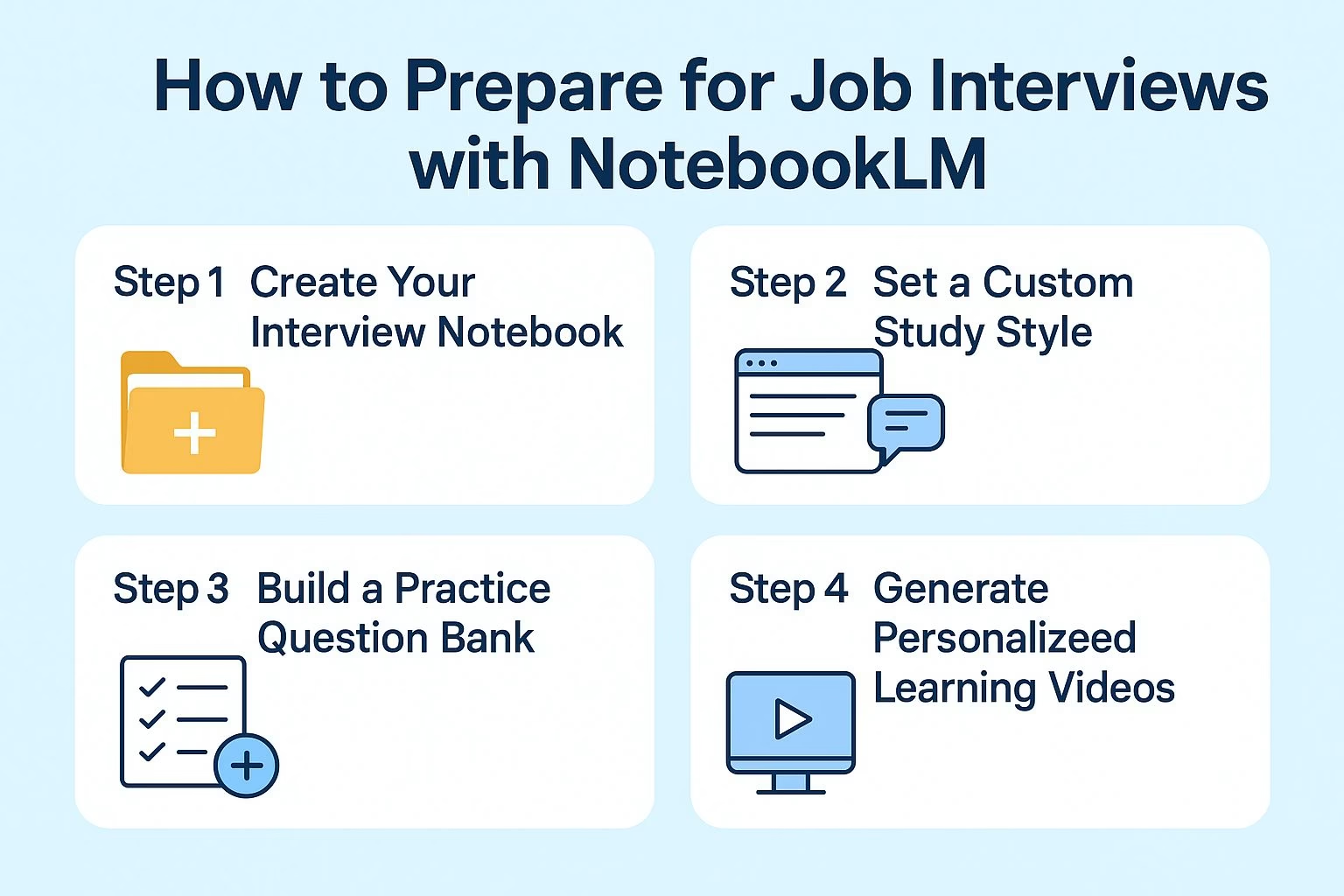How to Prepare for Job Interviews with AI
NotebookLM helps you:
1. Gather role-specific research from verified sources
2. Build a personal question bank and study video library
3. Practice with real-time coaching and structured feedback
4. Compare your reasoning across scenarios to improve adaptability
Preparing for a job interview becomes a lot easier when your research and practice materials are organized in one place.
NotebookLM helps you turn scattered notes and web content into a structured interview prep system that works like a personal coach.
In this tutorial, I’ll show you how to use NotebookLM to collect company insights, create your own question bank, and practice with tailored feedback.
You’ll learn step by step how to make the tool guide your preparation so you can walk into your next interview fully ready.
Let’s start with how to set up your first interview notebook and use it to gather relevant data about the company and role you’re targeting.
Step 1 Create Your Interview Notebook
Visit NotebookLM.
Click “New Notebook” and name it something descriptive, like “Goldman Sachs Data Analyst Interview Prep.”
This makes it easier to organize notes by company or position instead of mixing everything into one generic notebook. After naming your notebook, click “Discover Sources.”
Type this exact prompt:
I need sources to prepare for my Data Analyst interview at Goldman Sachs
NotebookLM will pull together materials such as role descriptions, recent company updates, and industry trends.
Example: If you’re applying for a marketing role at Google, you could write,
I need sources to prepare for my Marketing Associate interview at Google
This keeps your content relevant and lets you focus on company-specific information instead of wasting time sifting through general interview advice.
Step 2 Set a Custom Study Style
Once your notebook is ready, open the Settings menu and click “Custom” under style options. This setting tells NotebookLM how to guide your preparation.
Here’s how to configure it:
-
Style/Voice: Act as interview prep coach who asks tough questions and gives feedback
-
Goal: Help me crack the Data Analyst interview at Goldman Sachs
This setup makes NotebookLM behave like a real interview coach, challenging your answers instead of simply summarizing text.
Actionable example: Try typing,
What’s a challenging project I’ve worked on, and how can I describe it using the STAR method?
The tool will help refine your response and identify weak areas in your storytelling.
It’s an effective way to build confidence and clarity before your interview.
Step 3 Build a Practice Question Bank
Now that your study style is set, start building your custom question bank. Ask NotebookLM:
What are the top 5 behavioral questions for this role?
When the list appears, click “Save to Note.” Then use three dots → Convert to Source to add the questions to your study material. This converts them into searchable content that you can later reference while reviewing.
To make this even more useful, expand your bank by asking targeted prompts such as:
-
What technical questions are common for this position?
-
What situational questions test teamwork or leadership skills?
Example: If your target job is a Product Manager at Microsoft, ask:
What are the top 5 behavioral questions for a Product Manager interview at Microsoft?
You’ll quickly get role-specific material that matches your real interview scope. Save each set of questions in its own section to keep your practice sessions focused and efficient.
The more questions you gather, the stronger your preparation becomes. By the time you’re done, you’ll have a personal question database that mirrors what professional coaches use in paid training programs.
Step 4 Generate Personalized Learning Videos
NotebookLM lets you create videos that summarize or explain your notes. These work great for revising and internalizing key ideas.
Click the pencil icon next to “Video Overview.”
Then, update the focus line to read:
How to answer behavioral questions for Goldman Sachs Data Analyst interview
Click Generate. NotebookLM will create a short video in your chosen voice and tone, showing how to structure your responses and highlight your achievements clearly.
Actionable example: Watch the video and take notes on phrasing and tone. Then record yourself answering one of the saved questions in a similar way. Compare both versions and note where your delivery or reasoning could improve.
This approach is especially effective for behavioral and STAR-format questions because it helps you memorize the structure while sounding natural.
Step 5 Review and Refine Your Answers
Once you’ve built your study materials and generated your videos, it’s time to practice. Open your question bank in NotebookLM and start responding to each prompt out loud. Treat every answer like you’re in the real interview.
After answering, ask NotebookLM for feedback. Use a direct prompt such as:
Review my answer to “Tell me about a time you handled a conflict at work” and show how I can improve it.
NotebookLM will highlight weak spots, suggest stronger phrasing, and help you make your answers more structured. Repeat this process until your responses flow naturally.
Example: If you tend to ramble during interviews, try setting a timer for two minutes while answering each question. Then, paste your response into NotebookLM and ask how to shorten it without losing meaning. Over time, you’ll train yourself to be concise and confident.
To make your sessions more realistic, pair this with self-recording. Watching your delivery gives you insights into body language, tone, and pacing that text feedback can’t capture.
Pro Tip Compare Scenarios to Strengthen Reasoning
Strong candidates don’t just memorize answers. They recognize patterns in questions and adjust their reasoning. NotebookLM can help you practice this skill.
Create a new note titled “Scenario Comparisons.” Then ask:
How does my answer to “Describe a time you solved a problem” compare to “Explain a time you disagreed with a team member”?
NotebookLM will outline similarities in your logic and flag where you repeat examples or miss important details.
Actionable example: If both answers mention teamwork, rewrite one to focus on leadership or decision-making instead. This gives you a broader range of examples and keeps your responses diverse.
By practicing comparison, you’ll improve not only your content but also your adaptability. That’s what helps you stand out when the interviewer asks an unexpected question.

